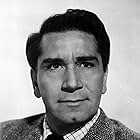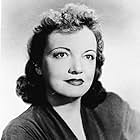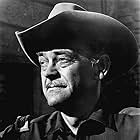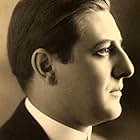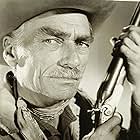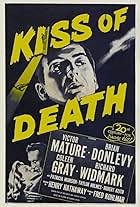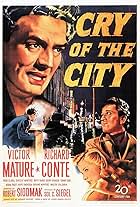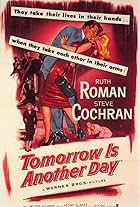Chicago reporter P.J. McNeal re-opens a decade-old murder case.Chicago reporter P.J. McNeal re-opens a decade-old murder case.Chicago reporter P.J. McNeal re-opens a decade-old murder case.
- Awards
- 1 win & 2 nominations
Joanne De Bergh
- Helen Wiecek
- (as Joanne de Bergh)
Robert Adler
- Taxicab Driver
- (uncredited)
Richard Bishop
- Warden of Stateville Prison
- (uncredited)
Larry J. Blake
- Police Photographic Technician
- (uncredited)
John Bleifer
- Jan Gruska
- (uncredited)
Truman Bradley
- Narrator
- (voice)
- (uncredited)
Dollie Caillet
- Secretary
- (uncredited)
Storyline
Did you know
- TriviaThe man administering the polygraph test to convict Richard Conte was the inventor of the polygraph or lie detector machine, Leonarde Keeler. He played himself in the movie.
- GoofsThere was enough of the newspaper showing by the newspaper boy to identify the issue date without seeing the date due to the images shown below the headlines. They just needed to match the pictures in the newspaper held in the background to a newspaper from the same date and see if the photographs match.
Look at the example from the photographs for the film (slide 93 of 118). There is enough to compare newspapers.
- Quotes
[McNeal is trying to get Zaleska to name his real partner in the crime and get a chance at parole]
P.J. McNeal: What have you got to lose? You're in for life now. C'mon, tell us the truth.
Tomek Zaleska: Sure, I could say I did it. Then maybe have a chance of getting out, like you say. But if I confessed, who would I name as my partner, Joe Doakes? I couldn't make it stick for one minute. That's the trouble with being innocent. You don't know what really happened. I didn't do it. Me and Frank had nothin' to do with it.
- Crazy creditsOpening credits are printed on the pages of a book; it is also stated that this is a true story.
- ConnectionsEdited from In Old Chicago (1938)
- SoundtracksChicago (That Toddlin' Town)
(1922) (uncredited)
Music by Fred Fisher
Played during the Prohibition montage
Featured review
This is a movie whose type later became familiar as "realistic crime-investigation narrative" primarily on the strength of a handful of films such as "the Lineup", "Kid Glove Killer" and this effort. It was in fact based on an actual 1932 case, we are told by historians, mostly on articles written by reporter James P. Mcguire. The one true thing said about the film by some of its recent reviewers is that the film benefits greatly--even looks modern to the 21st century eye--because it was filmed in the great city of Chicago and not on a Hollywood back lot. Solid director Henry Hathawy made use of unusual on-site lighting, locations and buildings to establish the milieu of the story-line in time and place. The plot line has one flaw, I suggest; I have seen it done as a TV one-hour drama and as this 111 minute feature, and it worked both ways for me because it features a straightforward "investigation" motif--a reporter trying to find out if a sentenced cop-killer is guilty or actually innocent. The flaw for me is the incredulity of the reporter before, during and long into his diligent and professional search for the facts in the case; anyone who knew anything about the police of the United States, Chicago especially, as they operated in 1932 and still operate today, would know two facts--that eyewitness identifications can, notoriously, be erroneously made; and that the justice system in the United States was then lacking in forensic sciences, politically corrupted and often set against minority-group defendants and suspects--conditions which have worsened in some respects since that time. Having said this, I add that the rest of the film is well-photographed, a good black-and-white, adventure, painstakingly presented. The script was adapted from the original articles as fictionalized biography by Leonard Hoffman and Quentin Reynolds, with screenplay by Jerome Cady and Jay Dratler. Cinematography by Joe Macdonald, music by Alfred Newman and consistent art direction by Lyle Wheeler and Mark-Lee Kirk, costumes by Kay Nelson and period set decorations by Walter M. Scott and Thomas Little all aid the realistic feel of this film very professionally. The body of the work comprises reports and arguments between a reporter, played ably by Jimmy Stewart, his editor --the powerful Lee. J. Cobb, and his wife, the attractive and capable Helen Walker, relative to his assignment-- finding out of Frank Wiecek was guilty of the crime for which he has served years in prison already. The case becomes an assignment for the ace reporter when he is assigned to investigate an offer of a reward for information leading to the man's exoneration; he finds out the offer of payment came from the man's aged mother who is scrubbing floors to feed herself and get money for this purpose. The case then turns on Stewart's ability to locate a missing witness, his growing belief in Wiecek's innocence and the use of a wire-photo, then a new and unusual technology, to prove that this star witness for the prosecution had been shown the accused--standard illegal police procedure--before she had made her original identification. In the cast besides Stewart who is charismatic, and very good though not ideal in the role, and Cobb and Walker, are many good actors. Kasia Orzazewski plays the mother, Richard Conte is good as Wiecek, Betty Garde is the elusive witness and Joanne de Bergh the wife who divorced the imprisoned Wiecek at his insistence. Among others in the cast are Moroni Olsen, George Tyne, Thelma Ritter, E.G. Marshall, Walter Greaza, Howard K. Smith, Samuel S. Hinds and Percy Helton. This is a deliberately paced and very realistic movie; it could have been done differently, but as noted above, my only reservation about its merits lies in the attempt to make the central character perhaps too annoyed at his assignment to be believable as a hard-boiled 1930s reporter a corrupt nation, city and legal environment. This is still a powerful and personal account of an injustice and how difficult it is in a bureaucratic country to right even the most obvious wrong. The film is memorable and often engrossing by my standards even today.
- silverscreen888
- Oct 25, 2005
- Permalink
Details
- Release date
- Country of origin
- Official sites
- Languages
- Also known as
- Calling Northside 777
- Filming locations
- Stateville Correctional Center - 16830 South Broadway Street, Joliet, Illinois, USA(Illinois State Penitentiary: panopticon & cells interiors; entrance exteriors)
- Production company
- See more company credits at IMDbPro
- Runtime1 hour 52 minutes
- Color
- Aspect ratio
- 1.33 : 1
Contribute to this page
Suggest an edit or add missing content











